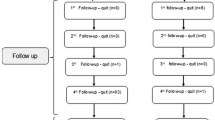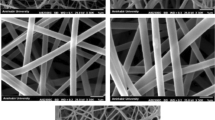Abstract
Background
The objective of the present study was co-delivery of venlafaxin (VEN) and doxycycline (DOX), a matrix metalloproteinase inhibitor drug, for alleviating inflammation and neuropathy in diabetic foot ulcer (DFU).
Methods
Bacterial cellulose nanofiber sheets (BCNS) were loaded with DOX and VEN and categorized by their loading efficiency, release profiles and ex vivo permeation throughrat skin. The optimized nanofibers were used in patients with DFU to compare with the standard wound care regimen during a 12-week trial. Wound area was measured every 2 weeks. Biochemical parameters and microscopic studies of the skin were examined prior and at the end of the treatment. The Michigan Neuropathy Screening Instrument (MNSI) questionnaire was utilized to assess diabetic neuropathy.
Results
The optimum formulation showed loading efficiency of 37.8 ± 1.6% for DOX and 48 ± 1.9% for VEN. Rat skin permeation was 40% for DOX after 7–29 h and 83% for VEN during 105 h. Patients treated with BCNS showed no significant difference in their biochemical parameters before and after intervention. The ulcer size showed faster reduction after 12 weeks in the treatment group compared to the control group. The abnormal responses in the MNSI questionnaire decreased and pain-free walking distance increased significantly in the treatment group compared with the control group (p < 0.001). Microscopic studies of the skin after using nanofibers showed a large number of polymorphonuclear chronic inflammatory cells and formation of new capillary beds.
Conclusions
The BCNS loaded with DOX and VEN may expedite healing and reduce neuropathy in the DFU of diabetic patients.
Graphic abstract








Similar content being viewed by others
References
Guariguata L, Whiting DR, Hambleton I, Beagley J, Linnenkamp U, Shaw JE. Global estimates of diabetes prevalence for 2013 and projections for 2035. Diabetes Res Clin Pract. 2014;103(2):137–49.
Frykberg RG, Banks J. Challenges in the treatment of chronic wounds. Adv Wound Care. 2015;4(9):560–82.
Moxey PW, Gogalniceanu P, Hinchliffe RJ, Loftus IM, Jones KJ, Thompson MM, et al. Lower extremity amputations—a review of global variability in incidence. Diabetic Med. 2011;28(10):1144–53.
Gianino E, Miller C, Gilmore J. Smart wound dressings for diabetic chronic wounds. Bioengineering. 2018;5(3):51.
Eming SA, Martin P, Tomic-Canic M. Wound repair and regeneration: mechanisms, signaling, and translation. Sci Transl Med. 2014;6(265):265.
Veves A, Falanga V, Armstrong DG, Sabolinski M. Graftskin, a human skin equivalent, is effective in the management of noninfected neuropathic diabetic foot ulcers: a prospective randomized multicenter clinical trial. Diabetes Care. 2001;24(2):290–5.
Falanga V. Classifications for wound bed preparation and stimulation of chronic wounds. Wound Repair Regen. 2000;8(5):347–52.
Mulder M. The selection of wound care products for wound bed preparation. Wound Healing South Afr. 2009;2(2):76–8.
Yan L, Shiya Z, Yanlin G, Yinglei Z. Electrospun nanofibers as a wound dressing for treating diabetic foot ulcer. Asian J Pharm Sci. 2019;14(2):130–43.
Backonja MM, Serra J. Pharmacologic management part 1: better-studied neuropathic pain diseases. Pain Med. 2004;5(suppl1):S28–47.
Grothe DR, Scheckner B, Albano D. Treatment of pain syndromes with venlafaxine. Pharmacotherapy. 2004;24(5):621–9.
Kadiroglu AK, Sit D, Kayabasi H, Tuzcu AK, Tasdemir N, Yilmaz ME. The effect of venlafaxine HCl on painful peripheral diabetic neuropathy in patients with type 2 diabetes mellitus. J Diabetes Complicat. 2008;22(4):241–5.
Richard P, Le Floch R, Chamoux C, Pannier M, Espaze E, Richet H. Pseudomonas aeruginosa outbreak in a burn unitrole of antimicrobials in the emergence of multiply resistant strains. J Infect Dis. 1994;170(2):377–83.
Vincenti MP, Clark IM, Brinckerhoff CE. Using inhibitors of metalloproteinases to treat arthritis. Easier saidthan done? Arthritis Rheum. 1994;37(8):1115–26.
Adhirajan N, Shanmugasundaram N, Shanmuganathan S, Babu M. Collagen-based wound dressing for doxycycline delivery: in-vivo evaluation in an infected excisional wound model in rats. J Pharm Pharmacol. 2009;61(12):1617–23.
Chen H, Xing X, Tan H, Jia Y, Zhou T, Chen Y, et al. Covalently antibacterial alginate-chitosan hydrogel dressing integrated gelatin microspheres containing tetracycline hydrochloride for wound healing. Mater Sci Eng C. 2017;70:287–95.
Huang L, Chen X, Nguyen TX, Tang H, Zhang L, Yang G. Nano-cellulose 3D-networks as controlled-release drug carriers. J Mater Chem B. 2013;1(23):2976–84.
Silva HFO, Lima KMG, Cardoso MB, Oliveira JFA, Melo MCN, Sant’Anna C, et al. Doxycycline conjugated with polyvinylpyrrolidone-encapsulated silver nanoparticles: a polymer’s malevolent touch against Escherichia coli. RSC Adv. 2015;5:66886–93.
Karani NA, Pingale P. Analytical method development & validation of venlafaxine hydrochloride in solid dosage forms using uv spectrophotometer. J Pharm Res. 2009;2(7):1246–9.
Salerno C, Carlucci AM, Bregni C. Study of in vitro drug release and percutaneous absorption of fluconazole from topical dosage forms. AAPS Pharmscitech. 2010;11(2):986–93.
Schaper NC, et al. Practical Guidelines on the prevention and management of diabetic foot disease (IWGDF 2019 update). Diabetes Metab Res Rev. 2020;36:e3266.
Feldman EL, Stevens MJ, Thomas PK, Brown MB, Canal N, Greene DA. A practical two-step quantitative clinical and electrophysiological assessment for the diagnosis and staging of diabetic neuropathy. Diabetes Care. 1994;17(11):1281–9.
Herman WH, Pop-Busui R, Braffett BH, Martin CL, Cleary PA, Albers JW. Use of the Michigan neuropathy screening instrument as a measure of distal symmetrical peripheral neuropathy in type 1 diabetes: results from the diabetes control and complications trial/epidemiology of diabetes interventions and complications. Diabet Med. 2012;29(7):937–44.
Moghtaderi A, Bakhshipour A, Rashidi H. Validation of Michigan neuropathy screening instrument for diabetic peripheral neuropathy. Clin Neurol Neurosurg. 2006;108(5):477–81.
Silva NHCS, Rodrigues AF, Almeida IF, Costa PC, Rosado C, Neto CP, et al. Bacterial cellulose membranes as transdermal delivery systems for diclofenac: in vitro dissolution and permeation studies. Carbohyd Polym. 2014;106:264–9.
Silvestre AJ, Freire CS, Neto CP. Do bacterial cellulose membranes have potential in drug-delivery systems? Expert Opin Drug Deliv. 2014;11(7):1113–24.
Trovatti E, Silva NHCS, Duarte IF, Rosado CF, Almeida IF, Costa P, et al. Biocellulose membranes as supports for dermal release of lidocaine. Biomacromol. 2011;12(11):4162–8.
Czaja W, Krystynowicz A, Bielecki S, Brown RM Jr. Microbial cellulose—the natural power to heal wounds. Biomaterials. 2006;27(2):145–51.
Suedee R, Bodhibukkana C, Tangthong N, Amnuaikit C, Kaewnopparat S, Srichana T. Development of a reservoir-type transdermal enantioselective-controlled delivery system for racemicpropranolol using a molecularly imprinted polymer composite membrane. J Control Rel. 2008;129(3):170–8.
Amin MCIM, Abadi AG, Ahmad N, Katas H, Jamal JA. Bacterial cellulose film coating as drug delivery system: physicochemical, thermal and drug release properties. Sains Malaysiana. 2012;41(5):561–8.
Man Z, Muhammad N, Sarwono A, Bustam MA, Kumar MV, Rafiq S. Preparation of cellulose nanocrystals using an ionic liquid. J Polym Environ. 2011;19(3):726–31.
Yang H, Yan R, Chen H, Lee DH, Zheng C. Characteristics of hemicellulose, cellulose and lignin pyrolysis. Fuel. 2007;86(12–13):1781–8.
Silva NHCS, Drumond I, Almeida IF, Costa P, Rosado CF, Neto CP, et al. Topical caffeine delivery using biocellulose membranes: a potential innovative system for cellulite treatment. Cellulose. 2014;21(1):665–74.
Shah BM, Khunt D, Bhatt HS, Misra M, Padh H. Intranasal delivery of venlafaxine loaded nanostructured lipid carrier: risk assessment and QbD based optimization. J Drug Deliv Sci Technol. 2016;33:37–50.
Kumar N, Das S, Jyoti A, Kaushik S. Synergistic effect of silver nanoparticles with doxycycline against Klebsiella pneumoniae. Int J Pharm Pharm Sci. 2016;8(7):183–6.
Patel HA, Shah S, Shah DO, Joshi PA. Sustained release of venlafaxine from venlafaxine–montmorillonite–polyvinylpyrrolidone composites. Appl Clay Sci. 2011;51(1–2):126–30.
Marques MS, Zepon KM, Petronilho FC, Soldi V, Kanis LA. Characterization of membranes based on cellulose acetate butyrate/poly (caprolactone) triol/doxycycline and their potential for guided bone regeneration application. Mater Sci Eng C. 2017;76:365–73.
Trovatti E, Freire CSR, Pinto PC, Almeida IF, Costa P, Silvestre AJD, et al. Bacterial cellulose membranes applied in topical and transdermal delivery of lidocaine hydrochloride and ibuprofen: in vitro diffusion studies. Int J Pharm. 2012;435(1):83–7.
Wei B, Yang G, Hong F. Preparation and evaluation of a kind of bacterial cellulose dry films with antibacterial properties. Carbohyd Polym. 2011;84(1):533–8.
Müller A, Ni Z, Hessler N, Wesarg F, Müller FA, Kralisch D, et al. The biopolymer bacterial nanocellulose as drug deliverysystem: investigation of drug loading and release using the model protein albumin. J Pharm Sci. 2013;102(2):579–92.
Shi X, Zheng Y, Wang G, Lin Q, Fan J. pH-and electro-response characteristics of bacterial cellulose nanofiber/sodium alginatehybrid hydrogels for dual controlled drug delivery. RSC Adv. 2014;4(87):47056–65.
Valo H, Arola S, Laaksonen P, Torkkeli M, Peltonen L, Linder MB, et al. Drug release from nanoparticles embedded in four different nanofibrillar cellulose aerogels. Eur J Pharm Sci. 2013;50(1):69–77.
Pavaloiu RD, Stoica A, Stroescu M, Dobre T. Controlled release of amoxicillin from bacterial cellulose membranes. Open Chem. 2014;12(9):962–7.
Salamanca CH, Barrera-Ocampo A, Lasso JC, Camacho N, Yarce CJ. Franz diffusion cell approach for pre formulation characterization of ketoprofen semi-solid dosage forms. Pharmaceutics. 2018;10(3):148.
Razazian N, Baziyar M, Moradian N, Afshari D, Bostani A, Mahmoodi M. Evaluation of the efficacy and safety of pregabalin, venlafaxineand carbamazepine in patients with painful diabetic peripheral neuropathy: a randomized, double-blind trial. Neurosciences. 2014;19(3):192–8.
Acknowledgements
The authors appreciate financial support of the project by Isfahan Endocrine and Metabolism Research Center.
Author information
Authors and Affiliations
Corresponding author
Ethics declarations
Conflict of interest
The authors declare that they have no conflict of interest.
Research involving human participants and/or animals
All procedures performed in this study involving human participants were in accordance with the ethical standards of the Isfahan University of Medical Sciences ethics committee (license code of 9531) and have been performed in accordance with the ethical standards as laid down in the 1964 Declaration of Helsinki.
Additional information
Publisher's Note
Springer Nature remains neutral with regard to jurisdictional claims in published maps and institutional affiliations.
Rights and permissions
About this article
Cite this article
Meamar, R., Chegini, S., Varshosaz, J. et al. Alleviating neuropathy of diabetic foot ulcer by co-delivery of venlafaxine and matrix metalloproteinase drug-loaded cellulose nanofiber sheets: production, in vitro characterization and clinical trial. Pharmacol. Rep 73, 806–819 (2021). https://doi.org/10.1007/s43440-021-00220-8
Received:
Revised:
Accepted:
Published:
Issue Date:
DOI: https://doi.org/10.1007/s43440-021-00220-8




